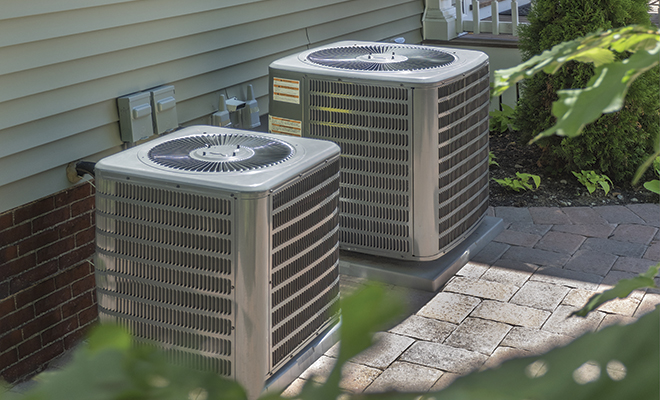
Goal: Comfort and Healthy Air
As you read this, you are probably seated either in your favorite chair at home, enjoying lovely air conditioning, or in your office, a cup of coffee beside you with the heat comforting you as fall arrives. Either way, someone, perhaps you, chose the heating, ventilation and air conditioning system in place.
HVAC systems not only provide comfort but produce safe air. Depending on the size of space you wish to heat or cool, there are four main types of HVAC systems you can choose from and many technologically improved add-ons to enhance your family’s life.
Classic Heating and Air Conditioning Split System
This traditional system has components both inside and outside the home. It typically has an air conditioner that cools the refrigerant; furnaces and a fan or evaporator coil to convert the refrigerant and circulate air; ducts to carry air, a thermostat or control panel; and optional air cleaners, purifiers, humidifiers, UV lamps and other components.
Hybrid Heat Split System
The advanced version of the classic split system offers improved energy efficiency. When a heat pump is included, it allows the option of having an electricity-fueled HVAC in addition to the typical gas furnace. Ideally a cost-effective hybrid heat split system will include a heat pump that heats or cools the refrigerant; furnaces plus the evaporator coil for conversion of the refrigerant and circulation of air; ducts to channel air; a control and optional accessories for quality indoor air. The system automatically selects the fuel source based on data from the control.
Duct-Free Split Heating and Air Conditioning System
This option is ideal for places and areas where the convectional systems with ducts won’t work. They complement existing ducted HVAC systems and consist of the heat pump or an air conditioner to heat or cool the refrigerant; a fan coil that is compact; wires and tubing for the refrigerant to connect the outdoor unit to the fan coil; thermostat; optional accessories to clean air and make it more pleasant before it blows through your home.
Packaged HVAC System
This compact system works for homes without adequate space for the separate multiple components of the split systems and heat and cool confined spaces that range from an entire home to a one-room unit. A packaged system can be simply for cooling or can combine components to provide electric only or gas and electric for cooling and heating; everything is in one unit except for the control.
Whichever system you choose, making sure you find a qualified professional to install or replace a system is of vital importance. Purchasing a heating and cooling system is one of the largest investments a homeowner will make. Ask friends, neighbors and co-workers for referrals, and check for available rebates.
A reliable company will be invested in educating you on your purchase, its operation and the additional technology that can make it work best for your family. Request references, then actually call the references. They will tell you about the contractor’s installation or service performance, and if they completed the job on time and within budget.
Energy Star is a good place to start and provides a detail list of qualified heating and cooling equipment that saves you money. Identify the needs for your home and find out about license and insurance requirements for the contractors in your state. Find out what model your current system is and its maintenance history before contacting a contractor. This will help them understand your needs.
Energy Star-qualified products meet vital energy-efficient guidelines that are set by the U.S. Environmental Protection Agency, and offer significant, measurable, long-term savings. Any contractor you hire should be able to show you calculations of savings for Energy Star heating and cooling equipment.
A good contractor will take time to inspect the system in place in your home to assess your specific needs. A bigger system is not always better, and he or she should size the heating and cooling system based on the size of your home, level of insulation and windows. Make sure your contractor inspects your duct system for air leaks and insulation, and measures airflow to make sure it meets the manufacturer’s specification.
Keep track of all estimates and compare the contractors’ proposals, bids and warranties. Just because one’s price is lower does not make it the best deal if it is not the most efficient, because your energy costs will be higher in the long run. Sign a written proposal with your contractor before any work is done. This will protect you by specifying project costs, model numbers, job schedule and the all-important warranty information. ■
Sources: energystar.gov, Wikipedia and servicechampions.net.







